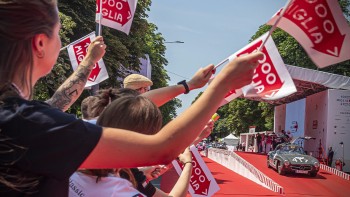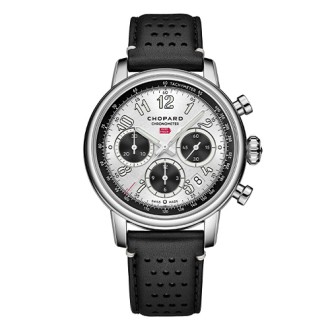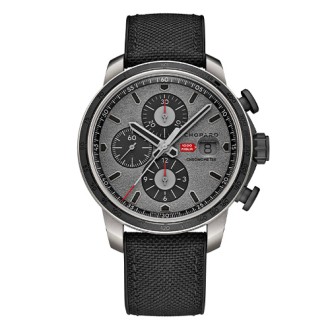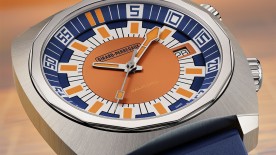It wasn’t the first time we had stalled the car that day – the clutch action on these 1950s motors can be tricky. But it was certainly the most memorable. Stalling is always a bit embarrassing. The engine splutters and goes silent, horns blare, eyes bore into you and time stretches as you fumble to restart it.

This time our sense of panic was heightened as instead of a few bystanders, we had about 200 people staring at us, wondering if we’d make it over the shoulder of the hill sometime this decade. Behind us, scores of collector cars impatiently bunched up, their path blocked by our static Fiat Zagato.
We were in Castagneto Carducci, Tuscany, on Day 3 of the 1000 Miglia classic car rally.
The Legend of the 1000 Miglia
Often called "the most beautiful race in the world," the 1000 Miglia, or Mille Miglia, first roared to life in 1927. Conceived by four automotive enthusiasts, the race covered a demanding 1000-mile (1,600 km) route from Brescia to Rome and back, attracting the elite drivers and carmakers of its day.
The competition was a triumph of engineering and daring, with legendary episodes like Tazio Nuvolari’s 1930 victory – driving his Alfa Romeo 6C 1750 GS without headlights to sneak past rivals at night – and Stirling Moss’s record-breaking 1955 run in his Mercedes-Benz 300 SLR.
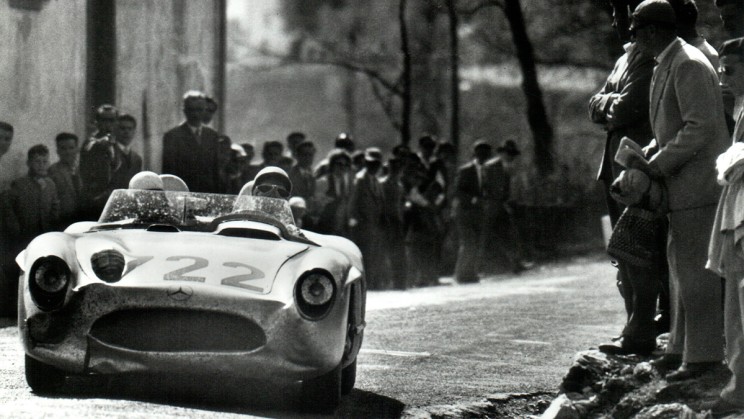
However, the original race was discontinued in 1957 after a tragic accident claimed the lives of driver Alfonso de Portago, his co-pilot and several spectators.
The 1000 Miglia Reimagined
Today, the 1000 Miglia has evolved from an outright speed race to a nostalgic regularity race for vintage cars, focusing on safety and precision, where the aim is to cover each sector of the route within a specific time and at a prescribed average speed. Only vehicles built before 1957 that participated in at least one edition of the 1000 Miglia from 1927 to 1957 are eligible.
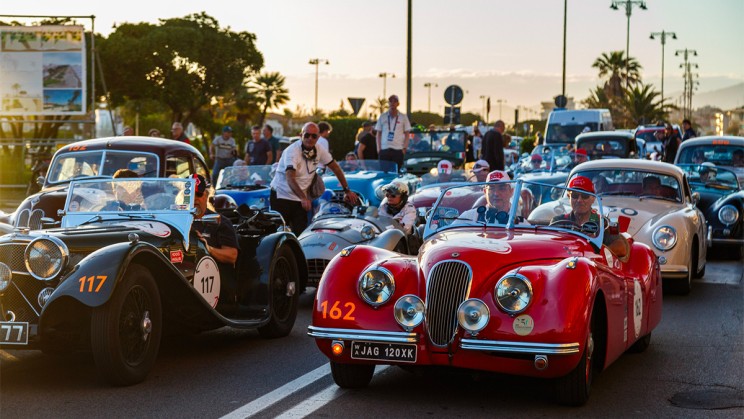
Still unfolding on the open roads, the rally takes place over five days in mid-June. The Brescia-Rome-Brescia route remains similar to the original, but this year it ran in reverse, passing down the Tuscan coast in the opening stages. The race now spans 2,200 km, with over 440 cars covering an average of 440km per day.
Navigating the Challenge
In this regularity race, drivers and co-drivers – or pilots and co-pilots – face constant time checks from start to finish. Time Controls allocate precise minute-long windows for starting and prescribe specific in-times for subsequent controls. Passage Controls ensure participants follow the correct route and Time Trials are discrete sections where you pass over pneumatic tube sensors. Arriving too early or too late, or driving too fast or too slowly, incurs penalty points.
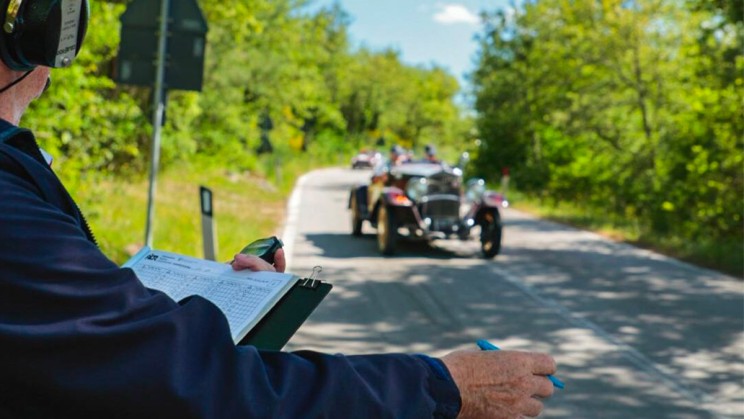
Using apps like Google Maps is prohibited. Instead, co-pilots rely on detailed roadbooks with tulip diagrams that break down each sector into bitesize chunks. This is paired with, at the very least, a trip odometer to record total and partial distances travelled, though serious competitors use a plethora of electronic instruments suction-cupped to their windscreens to gain an edge.
An Unexpected Adventure
My participation in this legendary endurance rally had been a source of amusement to friends and family in the run-up to it. I am, admittedly, indifferent to cars and a reluctant driver whose comfort zone is pootling around our small Swiss town in an unsexy automatic Skoda station wagon.
But there I was, thrust into one of the world’s most fabled rallies, thanks to Chopard. The luxury maison began sponsoring the 1000 Miglia in 1988, a year before its classic car-loving co-president Karl-Friedrich Scheufele first drove in the race alongside six-time 24 Hours of Le Mans winner Jacky Ickx.
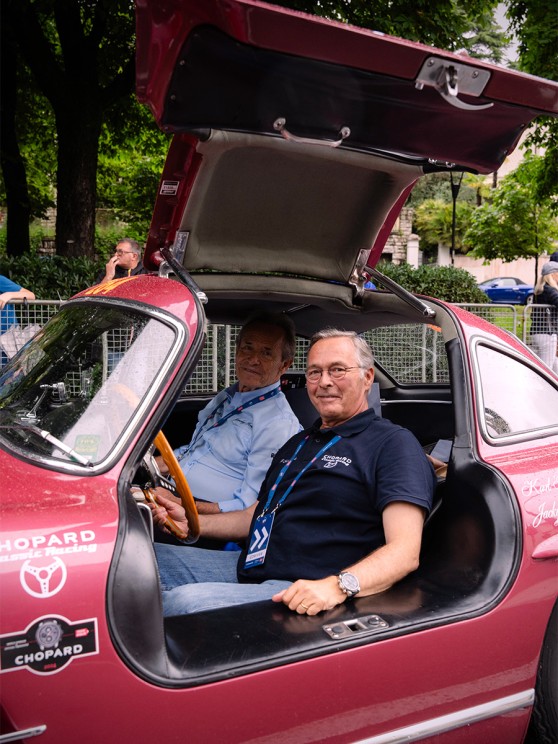
Scheufele has participated in every edition since and this year he was flanked again by Ickx in the Scheufele family’s "metallic strawberry" Mercedes-Benz 300 SL Gullwing.
As world sponsor and official timekeeper, Chopard releases race-themed timepieces for each edition of the rally. This year, the Mille Miglia GTS Chrono, featuring frosted grey dial and bead-blasted titanium case, was presented to each driver/co-driver pair. Available to all-comers was the fetching retro-tinged Mille Miglia Classic Chronograph with La Gara dial and Lucent steel case.
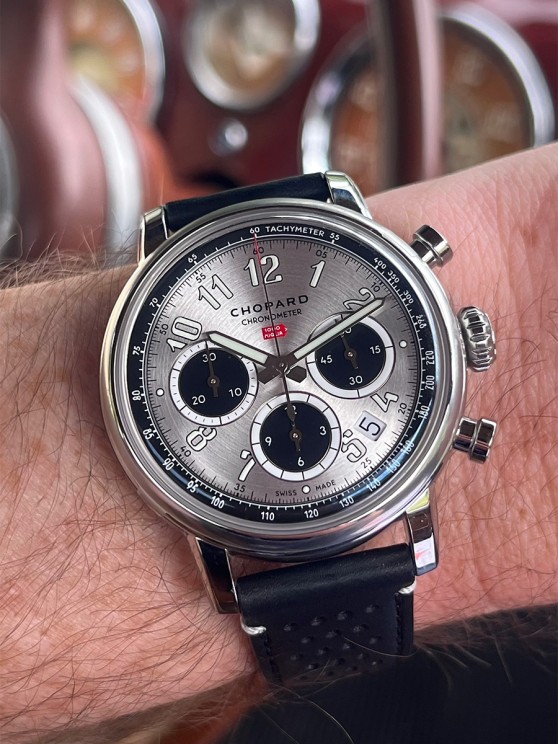
When Chopard asked if I and a few other lucky media members would like to join its team on the rally, I was delighted to accept, thinking I might cover the opening ceremony from Chopard’s booth on Brescia’s Piazza Vittoria or follow the race from a modern press vehicle. To my surprise, the brand invited us to be part of its official driving team – behind the wheel or navigating in the passenger seat – for two full days, from Turin to Rome!
Lessons from the Road
To observers, competing in the 1000 Miglia might look like a carefree jaunt around the Italian countryside in a dream machine from yesteryear. While it can feel like that, this is still a motorsport and it can be physically and mentally exhausting too.
On our first day, I was paired with German luxury editor Joern Kengelbach in a 1950 Fiat 1100 ES Berlinetta Pinin Farina. The following day, I teamed up with Spanish auto journalist Emilio Olivares Í Camps in an even rarer 1954 Zagato Fiat 1100 Berlinetta. All of us were race rookies.
Provided by Chopard via Pietro Tenconi’s Classic Car Charter, both gorgeous vehicles – valued at €300,000 and upwards – exemplify their coachbuilders' design philosophies with sleek lines and meticulously crafted curves.
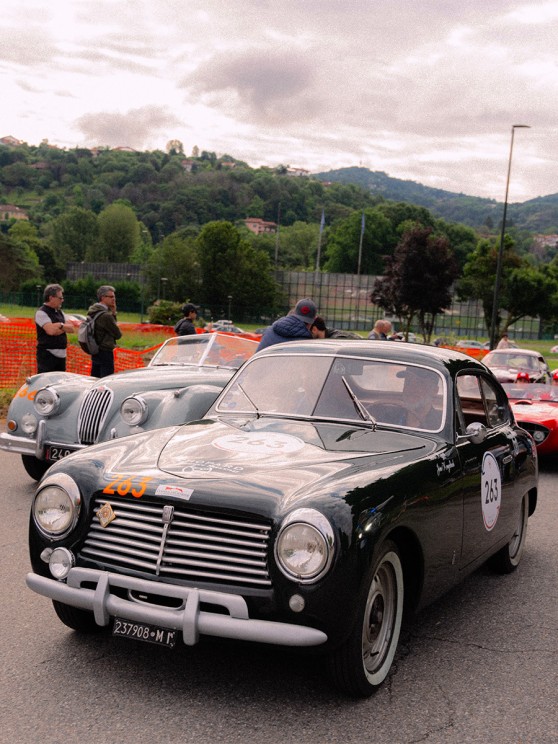
But they come with period-specific idiosyncrasies. There is no power steering or ABS, of course, so changes in direction and speed require anticipation and physical exertion. Changing gear demands vigorous effort too and, in the case of our Pinin Farina, double-declutching.
Both cars had beautiful but basic dashboards, one with a seemingly static petrol gauge. We had to refill the tank every 250 km so based our fuel stops on distance rather than what the needle indicated. When it rained, the windscreen wipers seemed to glide over droplets rather than disperse them. Luckily, we had paper serviettes on hand.
Obviously, there was no air conditioning, but we had to leave the windows down anyway to offset the aroma of petrol inside the car. At times you can feel enveloped – almost entranced – by the combination of these dizzying fumes, hot summer air and the engine's growl and vibration.
And there were no seatbelts, let alone airbags, which you try to forget when hurtling along at 100 km/h between modern 4x4s and HGV lorries; our cars had no more than 65 HP and weighed less than 700 kg.
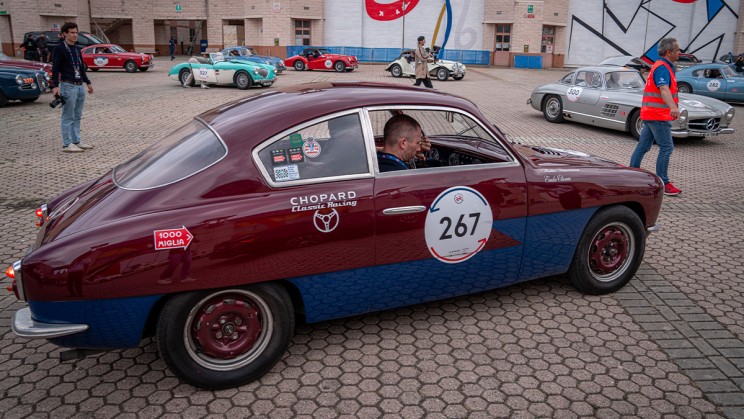
Yet, all these characteristics are part of these cars’ unique charm. They gave us a proper appreciation of the technology drivers worked with and the skill and physicality required to triumph back in the day.
Additionally, there is mental exertion. The pilot contends not just with other competitors but also support cars, police vehicles, regular traffic and revheads who unofficially join the race route. The co-pilot – my preferred role – must stay ultra focused, switching glances between the roadbook, odometer and road ahead, making split-second assessments and verbally guiding the driver with no room for ambiguity.
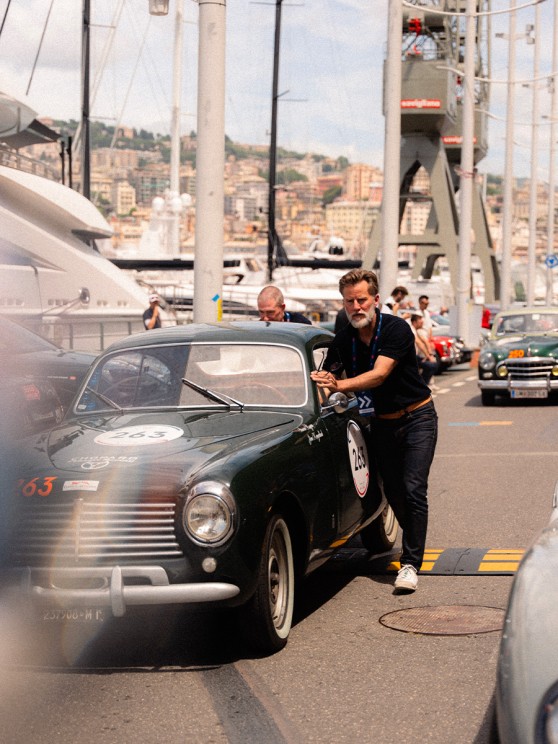
You can adapt to the physical and mental demands, but the long days magnify them. Setting off at 7 a.m. and, with only a brief lunch stop, staying on the road until after dusk… it turns out 12 hours of driving and navigating can be gruelling. We only took part in two legs of the race, so I doff my cap to those who manage all five days!
Joern and I didn’t even complete two full days: The head gasket of our Pinin Farina blew in stop-go traffic and midday heat entering Genoa. We pushed it half a kilometre to the port where Pietro and his team assessed the damage and deemed our day of racing to be over. Not to worry: breakdowns are part and parcel of the 1000 Miglia experience.
Rich Rewards
So, what’s the reward for this sapping test of driving skill, navigational savvy, physical exertion and mental endurance?
Firstly, the satisfaction of achievement. Racing in the 1000 Miglia wasn’t on my bucket list, but I’m so thankful I did it. This is a grail-worthy race with a waiting list double the number of participants and an entry fee starting at €15,250. Plus, you need the right car and a support team. Not everyone who aspires to it will ever participate. Most entrants looked like they were fulfilling a lifelong ambition.
In terms of the modern-day interpretation of the Japanese ritual of Misogi – an annual challenge that pushes you to your limits – the 1000 Miglia has been my Misogi for this year, following my first triathlon last year.
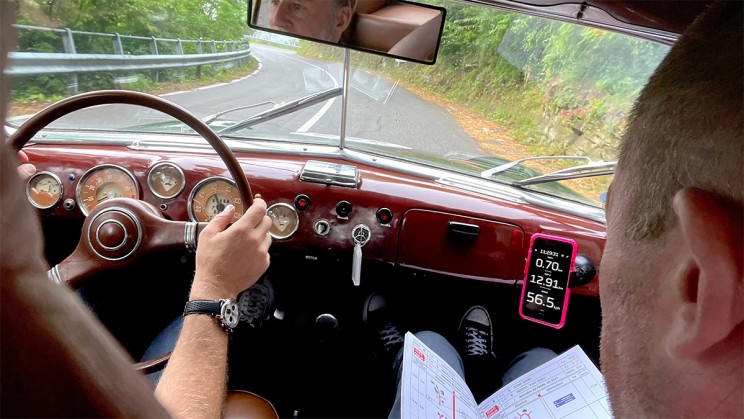
There’s also immense satisfaction when everything aligns in mastering the route and adhering to the speed and time requirements. While Joern, Emilio and I struggled to get to grips with the Time Trials – measured to the hundredth of a second – we managed the to-the-minute Time Controls pretty well.
And there’s no better feeling than correctly deciphering the abstract roadbook. As we entered Rome, I felt a surge of pride when a dozen cars took the wrong road, while we stayed on the right course thanks to my nuanced interpretation of the directions.
Admiring Automotive Icons
One of the benefits of racing in the 1000 Miglia is the front-seat vantage point to ogle the other cars. When I was alongside Emilio, he kept informing me of the rarity and value of the beauties we passed or that passed us, some worth millions.
There were some remarkable models, including a 1932 Alfa Romeo 8C 2300, known for its engineering and race-winning pedigree, and a 1950 Ferrari 166 MM Berlinetta Vignale, a masterpiece of mid-century Italian craftsmanship.
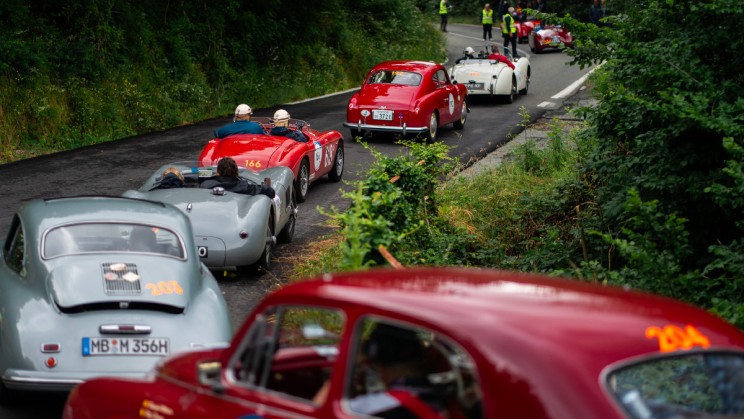
With its robust design and storied racing history, a 1929 Bentley 4.5 litre epitomised pre-war British engineering, while the sleek 1951 Jaguar XK 120 OTS Roadster showcased the country’s post-war design prowess.
A 1955 Porsche 550 Spyder RS impressed with its lightweight agility and racing heritage. And valued at over a million euros, a 1956 Ferrari 250 GT Coupé Boano featured Mario Boano's elegant design and a powerful V-12 Colombo engine. There was even a 1957 Citroen DS 19, highlighting the broad spectrum of automotive history on show in the 1000 Miglia.
Timeless Towns
Filing through quaint Italian towns with collector car after collector car accompanied by the incessant roar of engines felt like a trip back in time. Our journey took us through country and coastal roads, offering some breathtaking views.
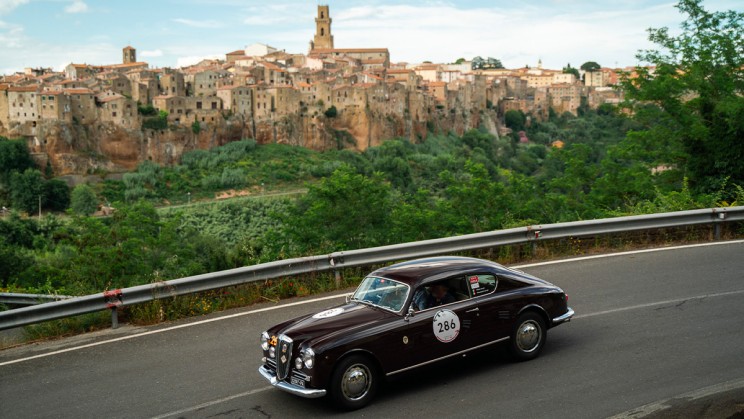
Passing through Aqui Terme, we were greeted by its historic charm and impressive fountains. Genoa’s bustling port was memorable as the scene of our breakdown. Viareggio's coastal allure provided a refreshing sea breeze, while Lucca's medieval walls and narrow streets whispered tales of centuries past. Ronciglione’s charming medieval centre was a delightful stop before our grand arrival in Rome.
Shared Bonds
In the 1000 Miglia, verbal exchanges between pilot and co-pilot are mostly about directions and the route. However, spending hours in close quarters with Joern and then Emilio allowed us to talk about more than just the road ahead. We discussed our jobs, passions, families and life stories. Sharing the experience of racing our first 1000 Miglia together turned strangers into friends. “Eres un amigo para siempre,” Emilio told me as we hugged, bone-tired but buzzing, upon finishing in Rome. I felt the same way.
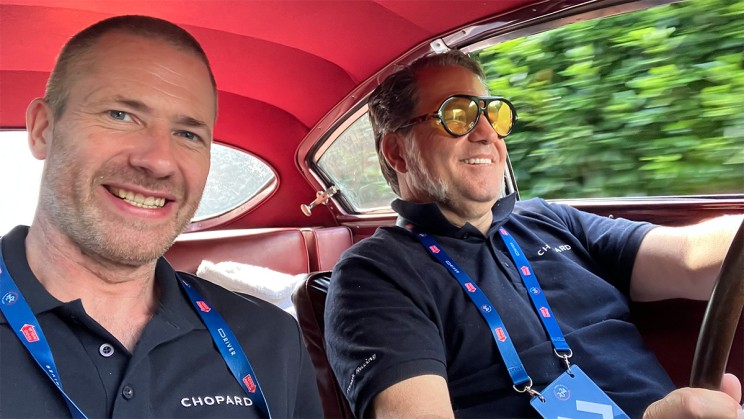
Both were solid drivers too and I’d like to think I returned the favour with decent co-piloting. When I finally channelled my inner Stirling Moss and took the wheel during a Time Trial in Lucca, I felt like a teenager learning to drive again as Emilio nervously coached me on my uncultured use of the clutch and gear shift. Grateful for his paternal instincts, I focused intently on not crashing into anything or anyone in the crowds.
People Passion
Aah, the crowds. Perhaps my biggest takeaway from the 1000 Miglia was the sheer, unconditional love shown to the cars and drivers by the Italian public. Maybe it is this "people passion" that distinguishes this classic car rally from others.
On the road, lorry drivers honk, moped riders give thumbs-up and drivers of civilian cars wave and pull over to let you through, not to mention the police motorbikes which provide an escort to ensure free passage.
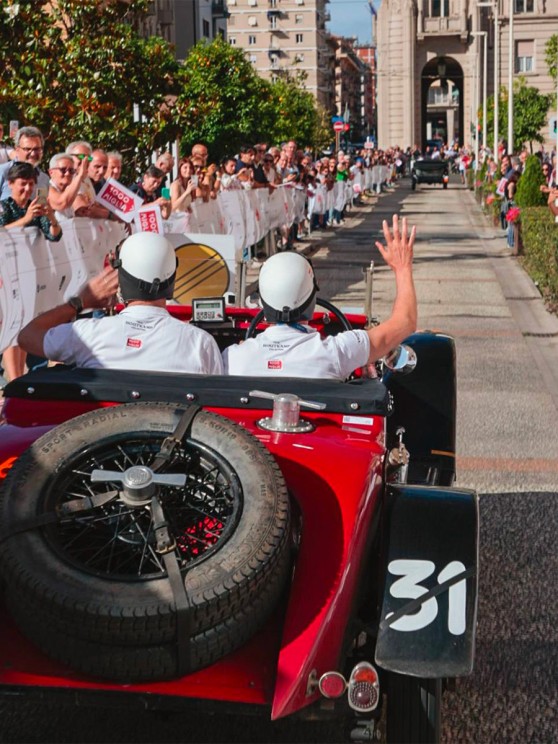
In towns and cities, men, women, children and pensioners set up picnic chairs, gather in cafés or stand by the roadside to cheer, giving whoops, claps and shouts of “Bravo!” We acknowledged their appreciation by beeping back, delight on their faces.
In Ronciglione, I asked an elderly couple what made the race so special for them. “Beautiful cars that not everyone drives,” the wife said. Her husband added, “Modern cars all look the same. Vintage cars, especially from the 1950s, have personality. Just like your car!” Zagato would have been proud.
When we finally overcame that hillside stall in Castagneto Carducci – thanks to Emilio’s nifty footwork and calm under pressure – the crowd roared as if we’d scored the winner in a cup final.
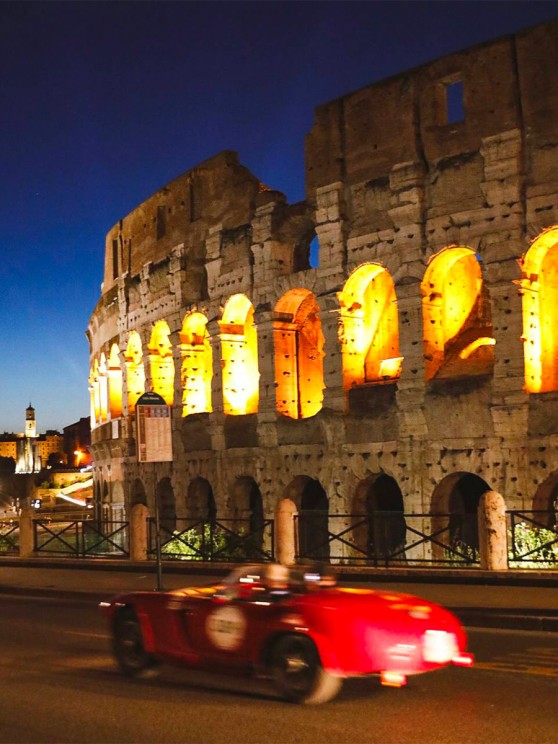
Receiving that show of love is intoxicating. It’s the scenario even the least needy of us crave: public adoration, being a hero for a day and putting a smile on a stranger’s face by simply showing up in a beautiful classic car.
As the race’s world sponsor, never has Chopard better embodied its tagline, “Artisan of Emotions.”
